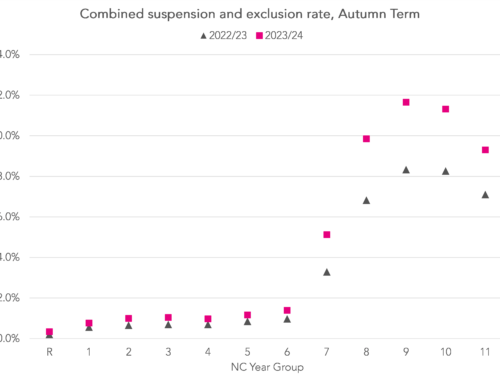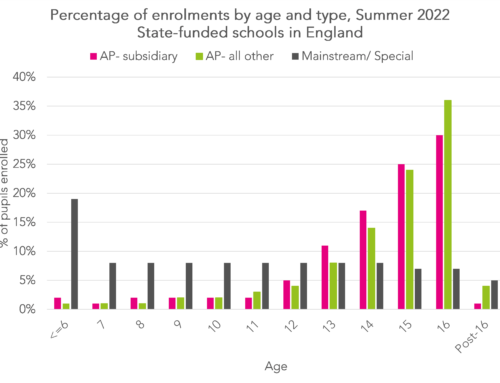This Government has invested enormous amounts of money and political capital in closing the attainment gap between children from low-income families, and everyone else. They give schools a pupil premium for children eligible for free school meals (and some other vulnerable groups) now worth £1300 for primary pupils and £935 for secondary pupils. They gave £125 million to create the Educational Endowment Foundation to find out how best to spend this money. Schools are now judged by Ofsted on what they are doing to close the gap and how far they have succeeded. But despite all this investment, commentators are arguing that the policy is failing because the pupil premium attainment gap isn’t closing. Using the performance metric of the proportion of children achieving five or more A*-C grades at GCSE including English and maths (5+A*-C EM), commentators appear to be right: the gap is falling so slowly that it will take about 250 years to succeed in closing the gap.

At first glance the gap between % 5+ A*-C GCSEs, including English and maths, for non-pupil premium and pupil premium children isn’t closing
On new accountability measures the gap is closing so fast that it will be zero by 2032!
From 2016 onwards, school performance will be judged on pupil grades across eight subjects: English and maths, three subjects from science, computer science, history, geography and languages, plus any other three subjects. On this Attainment 8 measure, the gap has been narrowing fairly consistently each year. This gap has been closing particularly rapidly for children achieving a Level 4B or better in Key Stage Two tests at age 11.

The Attainment 8 pupil premium gap has been steadily falling
We should not use five or more A*-C to monitor the gap since it ignores almost all improvements
Obviously getting five or more A*-C grades at GCSE is important for a pupil because it enlarges their future educational opportunities, but it is a poor measure for describing how an education system is performing. It is a threshold measure only capable of changing when a student successfully achieves a C grade instead of a D grade, and not if they achieve an E rather than F or indeed an A rather than a B grade. For many children, it is their grade in English or maths that prevents them achieving five or more A*-C, including English and maths. This means the school’s performance in this threshold measure hangs on the performance of one maths and one English teacher, each teaching the C-D borderline ability set for their subject.
Since some pupil premium children are very low attaining, it is very hard for a school to bring large numbers over the five or more A*-C threshold, even if they make very substantial improvements to teaching. By contrast, the grades of all pupils across a wide range of subjects contribute to Attainment 8 success, so it successfully identifies improvements even where they are happening for those pupils at the bottom (or top) of the attainment distribution.
Attainment 8 improves because grades improve AND because subject entry mix is changing
Schools have been entering pupils for more traditional or academic qualifications as a consequence of the English Baccalaureate performance measure. This is truer for their disadvantaged pupils simply because this group were less likely to be following this curriculum in the past. The gap in the number of Attainment 8 qualifying subjects has fallen from 1.13 subjects in 2011 to 0.81 subjects in 2014. By simply entering their pupils in for more qualifications, some of the gap can be narrowed. In fact, the pupil premium gap in entry patterns has now almost closed entirely for pupils with very high prior attainment.
However, performance in exams, as measured by average point score (APS), also matters. Here, the gap is also narrowing but more slowly from an average APS gap of 1.15 in 2011 down to 0.99 in 2014. In 2014, the closing of the APS gap stalled, perhaps due to changes in entry policy resulting from the Government’s announcement that they would only count a subject first entry in performance tables. However, overall both the narrowing of the entry gap and the narrowing of the average point score gap have contributed to the closing of the Attainment 8 gap. This is true for groups of children across all Levels of Key Stage Two prior attainment.
That said, the pupil premium gap will not close in the next 20 years. At some point, subject entry mix across different types of schools and pupils may largely converge, but grades achieved in subjects will not. Over the next couple of years, it is possible that Ofqual’s comparable outcomes policy will enforce an approximately similar distribution of grades awarded in a subject each year. This means that the attainment of pupil premium children can only improve if that of some other children falls.
We need to be realistic about the extent to which schools can compensate for differences in social background and parental support that families are able to provide, regardless of how much money or how many incentives we give them to close the gap.
Schools are putting enormous effort into making the pupil premium succeed. The gap at 11 is closing and the news that the gap at 16 is closing year-on-year too will bring great encouragement. It is very important that this success is recognised in debates about the future of the pupil premium.
John Dunford, Pupil Premium Champion
Measuring the attainment gap in terms of a threshold has always carried the danger of incentivising schools to focus too much on their middle attainers, those pupils most likely to cross the D/C grade boundary. So it is a pleasant surprise that the gap has in fact been narrowing in terms of the new broader academic Attainment 8 measure, which captures poorer pupils right across the academic spectrum, from high achievers to those really struggling in the classroom.
This gap however also only tells part of the story – there also exists a stark and widening divide between the most privileged pupils and the rest of children from low and middle-income homes. The evidence reveals a recurring trend: gaps take time to close, and other gaps emerge when they do. In the social mobility arms race, the privileged find new ways to gain advantage both within and increasingly outside the school gates. To nurture all our children, we will always need to mind not one but several gaps.
Dr Lee Elliot Major, Chief Executive of the Sutton Trust
It feels unfair to ask schools alone to close the pupil premium achievement gap when differences in out-of-school support for learning and development are so stark. This is particularly true in rural areas. Beyond schools, children need an enriching pre-school experience, great role models, a place to be able to complete homework, access to local services and public transport, a stable home life with parents that care about schooling, broadband and computer access, and access to wider community facilities such as libraries. We hope that the introduction of Progress 8 will provide secondary schools such as ours a more realistic target of equalising attainment for children with a similar starting point.
Liam Collins, Headteacher, Uplands Community College






does anybody know how to find the % of pupils that achieved each attainment 8 score a KS4 is a graph/data of % of students nationally. I can find the average attainment 8 scores per KS2 fine points but not the distribution of students nationally by attainment 8 score.
Does anyone know of any research undertaken/published re PP within privileged areas and the impact this might have on the mental health of PP students?